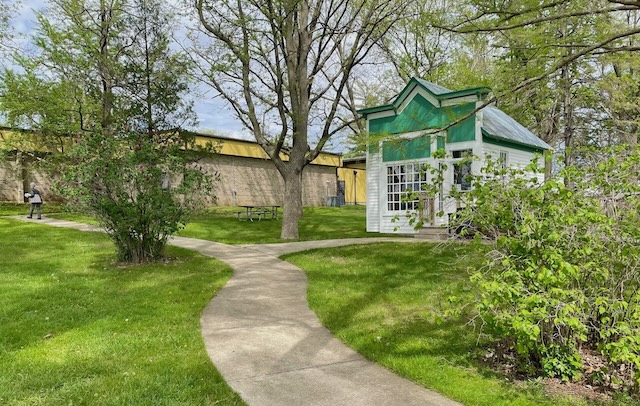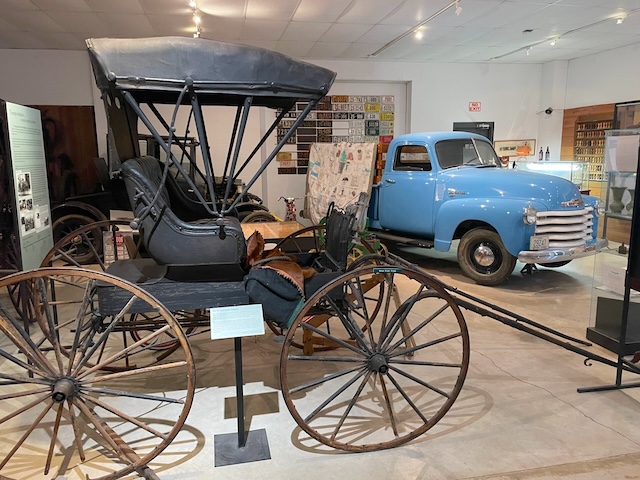
The Scale House with Baldwin Hall in the background at the Forest Park Museum and Arboretum. The museum and arboretum was originally developed in the 1940s and now is home to 17 acres of re-established prairie and wildflowers, a walking trail, and a collection of buildings and items portraying the history of Dallas County. It is located at 14581 K Ave. in Perry. Admission is free. The museum is open year-round, Monday through Friday from 8 a.m. to 4:30 p.m. May through October, it is open on weekends and holidays from 1 to 4 p.m. Photos by Carson Ode
Sept/Oct 2024 (Volume 16, Issue 5)
By Carson Ode
Forest Park is an appealing name for a museum and an apt description of what visitors experience when they visit. The museum buildings are placed amidst an arboretum consisting of evergreens, deciduous conifers, shrubs, bushes and 37 broadleaf deciduous trees. Nature trails provide hiking routes through a natural prairie with its prairie grasses and flowers and into a forest. It takes you back to the scene experienced by American Indians and early immigrants.
Eugene Hastie, an enterprising farmer, local historian and author, was also a collector of historical Dallas County objects. This collection grew when residents of the county began donating artifacts of their own. The accumulation of these items became museum-worthy, inspiring Hastie to set wheels in motion to make it a reality. With some organization in the 1940s, the displays began drawing attention. In 1953, it officially opened as the Forest Park Museum and Arboretum. It is a special legacy of this good man.
Two, huge, indescribable mechanisms that cannot be compared to anything you have ever seen, dominate the exhibits in Hastie Hall. They look like they are out of a Jules Verne novel. Redfield resident Henry “Hank” Nelson built them in an enormous shop attached to the back of his house. No one is quite sure whether the 1880s inventions worked. Many believe the “dynamo” was intended to generate electricity and the “arthritis machine” was designed to shoot an electrical charge to the affected area. Both are enclosed in elaborate, walnut wood configurations.
These weren’t the only creations from the active mind of Nelson. His life was broadened when he joined the U.S. Navy as a 17-year-old. He traveled the world with Teddy Roosevelt and the White Way Fleet. Also, in the Navy he learned the trade of coppersmith — skills that served him well the rest of his life. He inherited his inventive genius from his grandfather Nelson in Denmark, who invented the first steam engine in that country.
Nelson’s first invention at the age of 13 was the steel chicken coop. The sale of that patent paid the mortgage on his father’s farm. He went on to be granted 50 patents by the U.S. Patent Office. Two notable ones were the Rolscreen used in Pella Windows and the Drop-M-Lit smoking stand manufactured in Spirit Lake. He led an active, varied life from a wildlife enthusiast to an excursion boat operator to a professional bowler.

Hastie Hall display of a buggy, Model-T Ford and an early 1950s Chevy pickup.
Competing for space in Hastie Hall is another large exhibit — the Conestoga wagon. These freight wagons were pulled by teams of six to eight horses and could haul up to five tons of cargo. They served the pioneers well as they pushed west.
Other dominant displays in Hastie Hall are a horse-drawn buggy, a Model T Ford and a classic 1950 Chevy pick-up. A hand corn-picking wagon is the centerpiece of other agriculture artifacts. The wagon had a high backboard on one side and was pulled by horses. Farmers would walk alongside picking corn and throwing it against the backboard. Also, there is a Victorian parlor, complete with Victorian furniture and other household items representative of the period.
TO READ THE ENTIRE STORY AND OTHER FASCINATING STORIES ABOUT IOWA HISTORY, subscribe to Iowa History Journal.
